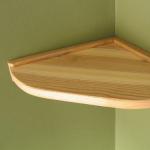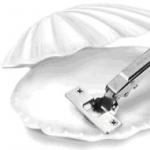A good harvest depends not only on proper watering and fertilizing the soil, but also on protecting it from pests.
Birds, moles, mice, voles and a whole range of insects - from which there is simply no salvation! The first, fortunately, can be scared away by ultrasound or, in extreme cases, get a couple of cats that will gladly disperse birds and mice from the site. But what to do with such a phenomenon as slugs and snails? By the way, the latter, at times, turn into a real scourge for strawberries, and what is most offensive is that you will not poison the crop with chemistry either.
Surprisingly fond of slugs and citrus fruits, especially grapefruit, the peel of which can be used to make a wonderful trap. To do this, cut the grapefruit in half and remove the fruit pulp. Make a hole in each of the halves, put it on a flat surface with a dome and leave it overnight. In the morning, your enemies will gather under the skin, and you can easily get rid of them.
By the way, if in addition to the garden you are breeding birds, snails and slugs will be a wonderful top dressing for them. However, this does not mean that you need to release the bird to the beds, because even though it is domestic, the love for appetizing fruits is not alien to it.
If everyday assembly is difficult for you, you can try creating an obstacle course in the path of snails using eggshells, sand or sawdust.
Due to the sharp and rough edges, the listed remedies are too unpleasant for soft-bodied slugs and, in search of food, they will bypass the area with strawberries and ground cucumbers surrounded by such a mound.
Note that you need to sprinkle each bush separately, and be sure to update the protective layer after rain or watering.
Strawberries are loved by children and adults. And not in vain, since this berry contains vital vitamins and minerals.
fresh strawberries
Juicy berry attracts not only people, but also pests. The main eaters of strawberries are slugs or slugs, as they are contemptuously called by the people.

Slug eating strawberries
Before you start growing this crop, you should learn how to deal with slugs on strawberries with the most effective gardening techniques.
To determine what will help strawberries from slugs, you need to study the habits of the pest.
A slug is a mollusc that lives on the surface of the earth. Outwardly, it is similar to a snail, but without a shell lost during evolution.
The mollusk is omnivorous, but the most favorite food for it is juicy leaves and fruits. From berries, slugs prefer to eat fully ripened strawberries.

Slug on a strawberry
Before wondering how to destroy slugs on strawberries, you should make sure that they are present.
The following signs help to detect a pest:
- holes on the leaves;
- silvery slimy traces;
- bitten fruits with traces of mucus.
Ways to exterminate slugs on strawberries
When thinking about how to protect strawberries from slugs, it should be borne in mind that slugs are nocturnal.

Slug fight
During the day, it is impossible to detect them due to physiological characteristics. The body of the pest mollusk is covered with mucus, which dries up under the rays of the sun.
During the day, it hides in moist places, including under leaves, in ground crevices, and other hiding places.
The ideal habitat for pests is moist soil, so when watering it is important to prevent waterlogging.
There are several types of remedies for slugs on strawberries:
- chemical;
- folk;
- mechanical.
The mechanical method involves the manual assembly of the pest. To facilitate work, it is recommended to lay out boards or large leaves around the site.
You can replace these materials with watermelon, melon or orange peels. All of them will serve as a shelter for shellfish.
During the day, they will gather in makeshift houses, so in the late afternoon they are easy to collect and destroy by hand.
Slug control with chemicals
How to get rid of slugs on strawberries using chemicals?
For these purposes, many drugs are produced. But all of them should be applied either before fruiting or after harvest.
What will help against slugs on strawberries? Experienced gardeners use several means as pesticides.
Metaldehyde or Thunderstorm
The drug or knows exactly what to do with slugs on strawberries. This is a finished product, produced in the form of granules.

Thunderstorm drug from slugs
They are scattered on the site in the places where slugs are supposed to live. Mollusks are happy to eat granules that cause intestinal poisoning in them. As a result, pests die.
The peculiarity of Metal hydride is that the granules are resistant to moisture.

Metaldehyde packaging
This property allows the drug to remain effective for 3 weeks.
Hydrated lime, ground iron sulphate
These substances powder the soil.

Slaked lime
The contact of the body of the mollusk with slaked lime or iron sulfate causes the death of the pest.
Bleaching powder

Bag of bleach
This mixture is also sprinkled on shellfish habitats. No less effective is tobacco dust.
The fight against slugs folk methods
How to deal with slugs on strawberries without using aggressive chemicals?
It is advisable to think about this before the enemy penetrates the gardener's lair. Slugs are a favorite food for hedgehogs and frogs. It is easy to attract them to your site.

Hedgehogs in the area
Gardeners do not feel a shortage of frogs. And you can attract hedgehogs by leaving them milk, chicken bones and other delicacies of animal origin overnight.
Mollusks live only in a humid environment, so it is necessary to equip the site with drainage.
The next measure to prevent their occurrence will be the thinning of thickened plantings that cause moisture accumulation.
The body of the mollusk is very delicate, not intended for movement on a rough surface. Therefore, the most effective folk remedy for slugs on strawberries will be strips of sand or crushed eggshells.
Strawberry plantings can be mulched with sawdust, pine or spruce needles. Coniferous carpet will bring double benefits.
It will not only prevent the invasion of pests, but also serve as an excellent fertilizer. Slugs are terrified of nettles. Gardeners dry it and lay it out in strawberry aisles.
The best folk remedy for slugs on strawberries, according to German gardeners, is beer. Moreover, slugs are gourmets who prefer dark beer.

Slug Beer
Beer is poured into plastic glasses cut from bottles. Having dug glasses into the ground, it remains only to wait until the clams drown, having drunk their favorite drink.
Experienced gardeners know how to water strawberries from slugs.
For these purposes, use the following:
- ammonia (1 part alcohol to 6 parts water);
- mustard powder (for 10 liters of water take 6 tablespoons of the powder);
- strong instant coffee.
Conclusion
Means that will help strawberries from slugs will protect other crops from the invasion of mollusks.
The absence of weeds, the absence of dense plantings and mounds of coarse-grained substrates will help prevent their appearance.
Another effective way to help both protect strawberries from slugs and other pests is deep digging of the soil. This method will not give pest eggs a chance to survive the cold winter.
Video: Strawberry pests. How to deal with slugs on strawberries.
The easiest way to get rid of snails (slugs) from strawberry beds is with ordinary wood ash. Ash can be obtained from the stove or after the fire. Initially, sift it and spray it over the beds with strawberries. Strawberries will be dirty with ash. After harvesting, the berries can be washed and dried. Thanks to this, snails (slugs) will no longer appear on strawberry bushes. There are other ways to get rid of snails - link in the source.
Of course, collecting snails by hand is absolutely not a rewarding job!
How to get rid of snails on strawberries?
In addition to ash, you can use sawdust, sand, seed husks (in the southern regions, husks are the most common remedy). Fill all furrows with any of these means - snails and slugs will not be able to get to the berry bushes.
On the site in general - mustard, tobacco, red capsicum, garlic - both in dry form and infusions are used to fight snails.
You can plant plants in high beds.
How to get rid of snails on strawberries?
When dealing with snails in strawberries or in a summer cottage, you should not use chemicals, since there is a considerable risk of human poisoning.
You can evict an annoying neighbor from the garden using natural remedies:
1) Plant garlic, parsley, lavender or mustard on a strawberry plantation. Snails do not tolerate these plants.
2) Use of traps. You can lure snails in a container of soapy water (dissolve 1/3 bar of laundry soap in 1 liter of water). During the night, 7-10 snails crawl into the tank. You can also lure snails to watermelon peels. Then put them in salted water.
3) The main enemies of snails are hedgehogs. Feed a hedgehog to the summer cottage and there will be no trace of the snails.
4) Spray the area where snails live, coffee, sprinkle the soil with tobacco dust, chalk or slaked lime. These funds well repel snails.
5) Barrier strips, for example, made of plastic bottles, prevent the penetration of snails. In this way, you can protect the strawberry plantation. The snails will not be able to overcome the high fence.
★★★★★★★★★★
How to get rid of snails in the garden?
Yes, snails in a summer cottage are not a very pleasant neighborhood. Therefore, it is better to get rid of them.
Adding to all previous answers. You can also scatter egg shells or fine gravel or needles around the beds. Snails do not like to crawl on prickly objects.
You can also sprinkle salt or crushed superphosphate around the beds. These substances dehydrate the snails and make it difficult to crawl.
You can plant sage or rosemary around the beds, snails do not like their smell.
You can make traps out of plastic bottles. Cut off the neck, pour beer into the bottle and dig into the ground. Put the cut neck on top of the bottle, after turning it over so that it is like a funnel. The snails will roll into the bottle.
You can scatter different cardboard boxes, boards, wet rags around the site. For the day, the snails will hide there, and in the morning you can walk around and collect all the snails.
You can also put dry nettles under the bushes of tomatoes, peppers, cabbage. Snails don't like her either.
Fight against uninvited "neighbors".
★★★★★★★★★★
You can get rid of snails with your hands))).
This is the easiest and safest, but long and tedious way. Snails are nocturnal and should be collected after rain or towards sunset when they start to crawl out of their hiding places. But to attract them, you can also create artificial shelters, where during the day they will hide there (old boards, wet rags, cabbage leaves, etc.). After that, it remains only to check the meta, and collect the "harvest".
If you have a personal reservoir (pond) in the garden, get a few toads and frogs there.
To combat snails, you can also use the method of insurmountable obstacles. Due to their delicate and soft body, snails are not able to overcome the barrier strip, which consists of various fragments of piercing and cutting objects. The water barrier is also insurmountable for them.
Can be used as a trap and grapefruit peel. To do this, you need to make a hole in half of the peel and put this trap like a dome at night. This smell attracts snails, and in the morning it remains only to check the traps and destroy what has accumulated in them during the night.
They also avoid contact with copper. When touched, the snails receive a small electrical discharge. And now for these purposes special tapes with a battery are sold.
Exotic lovers can recommend a method of dealing with snails by spraying plants with 1 or 2% aqueous caffeine solution. Caffeine is quite capable of killing them. Of the side effects of this method, it can be distinguished that it discolors the leaves of some plants in the treated areas. A caffeine concentration of 0.1% is already capable of scaring off snails, introducing them into a stupor, a state of confusion, and increasing their heartbeat.
To obtain a caffeine concentration of approximately 0.1%, it is necessary to dilute a double dose of instant coffee in a cup of water, or slightly less than natural.
How to protect strawberries
from slugs and snails
 There are many who want to enjoy fragrant strawberries. Slugs, snails and birds can taste ripe berries faster than you. And what is most offensive is that you will not poison the crop with chemistry, because you yourself will have to eat it.
There are many who want to enjoy fragrant strawberries. Slugs, snails and birds can taste ripe berries faster than you. And what is most offensive is that you will not poison the crop with chemistry, because you yourself will have to eat it. It's hard to disagree that slugs are a pretty nasty scourge. at first they spoil almost every strawberry or strawberry. Then they move in an organized manner to peppers, tomatoes and eggplants, gnawing holes in the fruits, and sometimes even settling in them. In addition, the same slugs spoil cucumbers and cabbage. They also eat out depressions in the roots of carrots and beets. Is there really no escape from this?
To make growing strawberries at home easier and to protect the berries from pests, there are many different ways.
To protect your crop, slug control measures must be carried out systematically.
Here are the main defenses:
1. It is necessary to carry out agrotechnical measures throughout the entire growing season, namely, carefully loosen the soil, mow the grass along the sides of the paths and around the site (the absence of weeds deprives slugs of food.)2. It is effective to carry out nightly collection of slugs in a jar of kerosene or detergent solution.3. It is necessary to lay out bait traps, these can be wet rags, boards, slate, etc., under which they like to hide. In the morning they must be collected and destroyed.4. A good way is to dust the soil surface with freshly slaked lime - 30 g per 1 sq. m or superphosphate - 30-40 g per 1 sq. m. (lime treatment should be carried out early in the morning or late in the evening, when the slugs crawl out and begin to feed.)5. You can apply the following method: it will require only an incomplete tablespoon of ammonia and a manual sprayer. Treat each shelter two or three times - and the slugs are over. After a week and as pests appear, it is advisable to repeat the spraying. It is better to spray in the evening, in calm weather. This method is absolutely safe for humans, and doubly useful for plants: get rid of slugs and carry out foliar fertilizing with nitrogen.6. Very effective is the sieving of metaldehyde granules (Thunderstorm, G (60 g / kg)) on the surface of the soil between rows, paths - 30 g per 10 square meters. m. In the evening, it is scattered or in the form of baits laid out in heaps (on a thimble) directly on the ground or on pieces of plywood, glass, film, cardboard. The bait works without losing its effectiveness after rains for more than two weeks.7. If the slugs are wound up in the baseboards of the house or in the basements, in the cellars, then you need to pour a solution of salt there (200 g per 10 liters of water).8. You can create an obstacle course for slugs and snails using eggshells, sand or sawdust. Due to the sharp and rough edges, these substances are too unpleasant for soft-bodied slugs and in search of food they will bypass the area with strawberries surrounded by such a mound.It should be noted that you need to sprinkle each bush separately, and be sure to update the protective layer after rain or watering.9. Beds and flower beds with strawberries or strawberries can be protected if slaked lime, dolomite flour, sawdust, straw, crushed superphosphate or ground pepper, salt are poured around the perimeter. These funds irritate or dehydrate the delicate body, making it difficult for them to move.10. A bottle of beer can serve as a wonderful trap for slugs and snails, which attracts pests even better than the most homemade soil strawberries.11. Oddly enough, they love slugs and citrus fruits, especially grapefruits, from the peel of which you can make a wonderful trap. To make a trap, cut a grapefruit in half and remove the pulp from the fruit. Make a hole in each of the halves, put it on a flat surface with a dome and leave it overnight. In the morning, your enemies will gather under the skin, and you can easily get rid of them.12. It is known that slugs and snails do not tolerate the smell of parsley, garlic, sage, rosemary, so these plants, planted around the perimeter of the site, will repel pests.
Important! Treatment with lime, superphosphate and metaldehyde should be carried out no later than 20 days before harvest. On green crops - onions, dill, parsley, lettuce - chemical treatment cannot be used, since these vegetable crops are used for food constantly and without heat treatment.
In the natural environment, slugs are eaten by beetles, hedgehogs, shrews, toads, moles and other animals.
Protecting plants from slugs and snailsA few years ago, snails appeared in our dacha cooperative, first on the outskirts of the village, and then everywhere. Before that, only slugs pestered us, and in recent years, both. There were so many snails in some areas that summer residents collected them in buckets.
Every morning I looked for them on dahlias, echinocea and horseradish. There were especially many snails on the border with other areas. Neighbors rarely came, the garden was overgrown with weeds, and pests were spreading in all directions. No ditches saved, so these creatures crumbled from long weeds.
Snails and slugs eat everything: strawberries, vegetables, flowers, leaving miserable twigs behind, and the fruits they gnawed disappear from fungal diseases or rot from the mucus that mollusks leave behind. During the day, especially in hot weather, they hide under leaves, boards, stones, and in the evening and at night crawl out onto plants. Despite the fact that snails and slugs are garden orderlies, destroying dead plants, but their huge number does much more harm than the benefits they bring. And therefore they must be fought.
There are different ways.
1. Slugs and snails do not tolerate the smell of parsley, garlic, sage, rosemary, so these plants, planted around the perimeter of the site, will repel pests.
2. Beds and flower beds can be protected if slaked lime, dolomite flour, crushed superphosphate or ground pepper, salt are poured around the perimeter. These substances irritate or dehydrate the delicate body, making it difficult to move.
3. You can also sprinkle egg shells or fine gravel (? ...) around the perimeter of the beds or flower beds, the sharp edges of which do not make it possible to crawl.
4. Slugs and snails prefer to eat berries, fruits, vegetables, therefore they react to the smell, and, as gardeners have noticed, they are very fond of beer. They can be collected in spaced traps: cut plastic bottles in half, cut off the screw part from the neck, pour some beer into a glass, and close it on top with the top of the bottle neck down. Drip this device into the soil. Slugs and snails will crawl into the bottle on their own, but they will not be able to get out.
5. In order not to look for these pests throughout the garden, you can lay out boards, cardboard, rags around the area where they will hide for a day and can be easily collected.
6. There are also chemical means of protection against slugs and snails, for example, the Meta preparation, which is scattered over a 30 g area by 10 m. This preparation kills pests, but pets can suffer from it.
7. Recently I learned about another method: lay copper wire or rings around the perimeter (beds or flower beds), they will scare away, as an electric current will occur upon contact (? ...). This method is new for me, I hope to check its action in the summer.
In order not to have to deal with snails and slugs, it is necessary to deprive them of their daytime shelter: regularly mow the grass, do not leave weeds on the paths, remove boards, logs, constantly loosen the soil so that they cannot hide there.
http://maltzevaswetl.ru.xsph.ru/?p=195#more-195
 Using hot water against slugs
Using hot water against slugs
I heard from gardeners about harmless methods of struggle associated with the fact that high temperatures are unbearable for slugs.
One of the most effective ways is when the beds are mulched with a transparent film. At night, slugs gather under this film, and during the day, when the soil is heated by the rays of the sun, they die - they cannot withstand the resulting “steam room”.
On hot summer days, when there are no open areas of soil between the grown plants, resistant plants can be watered against slugs with hot water. Slugs die when treated with water heated to 40 degrees.
For example, cabbage can be watered over the leaves with fairly hot water (60 degrees).
Slugs die as soon as this hot shower hits them. Cabbage does not suffer at all.
Treatment of plants with hot water should be done at dusk, when pests crawl out onto the leaves.
Protecting plants from slugs
To protect individual plants from slugs, it is advisable to use dry mineral fertilizers (potassium salt, superphosphate), scattering them on the soil around the plant. Moreover, one such treatment is not enough. After all, after contact with these substances, slugs, trying to protect themselves from irritation, secrete a large amount of mucus and, together with it, dump the drug that has fallen on them.
Therefore, the first treatment acts on slugs only intimidatingly, and only the second one guarantees complete destruction. The treatment interval is 30-40 minutes.
Killer effect on pests and special preparations (for example, "Meta", "Thunderstorm"), but on condition that they hit directly on the slug.
When using “chemistry” against slugs, remember that this is not safe for garden soil, as well as for useful garden creatures, and for gardeners themselves!
Pollination with chemicals should be stopped 3 weeks before the ripening of fruits and berries.
During this period, a mustard solution can be used to treat plants from pests (150 g of dry mustard per 10 liters of water).
Pollination and spraying of plants against slugs is recommended late in the evening.
Means of mechanical control of slugs and snails
Special traps for slugs and snails are a bowl covered with an umbrella-roof. The trap is installed in the ground so that the entrances to it are at the level of the ground surface. The bowl is filled with beer, fruit juice or other bait (the delicious smell attracts snails and slugs), and the roof over it prevents rainwater and debris from getting inside. In the absence of such a trap, pour the bait into simple bowls from an old unnecessary set and dig flush with the soil surface in places with plants, your favorite snails and slugs. Check and empty the traps regularly in the morning.
Maneuvers that distract snails and slugs include old leaves and tops of garden plants (lettuce, tomatoes, cucumbers, medicinal comfrey, etc.) scattered near the plantings. I successfully use this method in a greenhouse, which helps me keep not only slugs and snails, but also wood lice away from plants. Carried away by eating this waste, the pests no longer crawl to the vegetables growing in the greenhouse. I periodically collect drying waste and pests that eat them, replacing green traps with fresh tops.
Phyto-control agents for slugs and snails
Plants that slugs and snails do not like and try to avoid are primarily garlic, as well as many (but not all!) Aromatic plants (lavender, sage, hyssop, santolina, thyme or thyme, rosemary, laurel, etc.). ), which slugs and snails never touch.
Garlic is used by manufacturers for special herbal infusions that repel slugs and other pests from plants. In addition to garlic infusion, hot pepper infusion and mustard infusion are well-known folk remedies for fighting slugs and snails.
http://www.gardenia.ru
There are many ways, including dusting with ashes, sanding, etc., to make it difficult for them to crawl. Also use mechanical assembly - lay out planks, and preferably burdock leaves. Snails love burdock and congregate under it. Lay out in the aisles, then remove the snails from them. Belkina Svetlana
The poison does not particularly affect them, sprinkle ash or metaldehyde around the plants (the Thunderstorm of slugs is called) in the first case they do not crawl in the dry, in the second they burn their belly and die. elena orlova
Gather. Sprinkle the most valuable crops around with coarse salt or ground eggshells. They have a delicate abdomen that will not crawl. Valentina Lichikova
These pests can be collected and destroyed or fed to chickens. To do this, you need to lay out pieces of slate in their feeding places: slugs climb under them at night, so during the day you just need to turn the slate over and collect pests.
You can use poison against slugs - metaldehyde, which is sold under the names "Meta" or "Thunder". Under each leg of cabbage next to the stem, put 3-4 granules of metaldehyde. When the slugs crawl onto the cabbage at night, they will burn their belly on these granules and die. But metaldehyde is a pretty strong poison, and you should be aware of it.
There is an old, old-fashioned method against slugs: dilute 0.25 cups of 9% vinegar in a bucket of water and pour cabbage with this solution on top of the crown in the evening. There is one more recommendation - to twist a nettle stalk around the cabbage leg. Slugs are afraid of nettle burns. True, in a humid summer, with a large accumulation of slugs on the site, they eat nettles.
There is an interesting observation of gardeners: slugs love beer. In those places where pests have gnawed large holes on the leaves of plants, dig half-liter jars in the evening (the edges of the jars are flush with the soil), splash beer on the bottom of which. Slugs will climb into jars, seduced by free drinks, but they won’t be able to get out of glass jars, in the morning you will collect them in one jar and fill them with heavily salted water. After death, you can throw the slugs on the compost heap, the birds will peck them willingly. All these methods are suitable for fighting snails. Galina
Mulch the soil with sawdust. Only if the sawdust is fresh, it is necessary to pour it with a solution of urea. Overripe sawdust is better. And one more thing: sleeping coffee helps well. Caffeine, even in a minimal amount, paralyzes the nervous system of slugs and they die. Julia
http://ponarodnomu.ru/answers/a_rassada.htm
 Under plants of tomato, pepper or eggplant, to which slugs are great lovers, you can lay out dried nettle plants. Slugs are afraid of them, and if there are enough nettles, they will prefer to bypass this place. Treat yourself to a beer! Slugs and snails can’t resist beer, even if it’s stale (they are true connoisseurs of this drink and, according to German gardeners, prefer its dark varieties). You can take advantage of this addiction by breaking glasses into the ground and filling them halfway with beer. Especially immoderate ones simply drown in beer, more abstemious "fall off" next to the "life-giving source". The method is original and, as it was said, very effective - two or three such "feasts" and you can forget about slugs until the end of the season.
Under plants of tomato, pepper or eggplant, to which slugs are great lovers, you can lay out dried nettle plants. Slugs are afraid of them, and if there are enough nettles, they will prefer to bypass this place. Treat yourself to a beer! Slugs and snails can’t resist beer, even if it’s stale (they are true connoisseurs of this drink and, according to German gardeners, prefer its dark varieties). You can take advantage of this addiction by breaking glasses into the ground and filling them halfway with beer. Especially immoderate ones simply drown in beer, more abstemious "fall off" next to the "life-giving source". The method is original and, as it was said, very effective - two or three such "feasts" and you can forget about slugs until the end of the season.
Instead of glasses, other containers are also suitable. For example, in the most low areas, you can install a whole basin, or you can get by with glasses made from plastic bottles. Or take whole plastic bottles, pour some beer and lay flat on the ground, crumpling one side a little so that the bottles become flat and do not roll around.
It is worth noting that molluscs especially avoid substrates such as ash, superphosphate or lime. Superphosphate by today's standards is, of course, an expensive thing, so it's easier to stop at ash or lime. Perhaps the simplest remedy is to sprinkle the aisles with lime after rain or watering, when the slugs begin to move actively. Getting on strips of lime, they burn their abdomen and die. You can take not pure lime, but mixed with ash or tobacco dust (1: 1).
In the absence of rain, the soil is thus cultivated late in the evening or at night, when the slugs are on the soil or on the plants. Soil treatment is periodically repeated (after 7-15 days), which leads to the gradual death of mollusks. The main thing when carrying out this procedure is to successfully choose places for dispersing drugs in order to block the main routes of their movement for slugs. It should be borne in mind that filing is effective when the slugs "graze" - that is, after sunset.
You can sprinkle powders on the ground, for example, finely crushed iron sulphate mixed with sand. Slugs die from contact with this mixture. Very caustic to slugs and soot. They do not like dry sawdust, they avoid places smeared with tar. Shrubs were protected from them by making a ring of cotton wool five cm wide at the base of the trunk and smearing it with tar or any sticky resin.
To protect garden strawberries, it is recommended to sprinkle the ground with spruce or pine needles or put a layer of spruce or pine legs on the soil. The needles themselves will crumble to the surface and serve as protection against slugs. In addition, they will protect the soil from drying out and then serve as a fertilizer. And the skeletons of spruce and pine legs will serve as support for the berries, protecting them from contact with the ground. For dessert, grapefruit.  American gardeners recommend a very original way of catching slugs using grapefruits, it is enough to take half the peel of a grapefruit, cut a small hole in it and set up this domed trap. Attracted by the smell, the gastropods will gather under the skin overnight, and in the morning it remains only to collect them and eliminate them by placing them in boiling water or in a concentrated solution of table salt. However, in our conditions it is easier to catch slugs in more accessible (and most importantly, available in any garden plot) traps. As the latter, ordinary trimmings of boards, pieces of slate or roofing felt, wet rags and burlap, linoleum, watermelon peels, cabbage leaves, etc. are quite suitable - slugs like to crawl into such shelters for a day. And you just need to spread out all these items in the evening in suitable places, and in the morning go and collect the mollusks hiding in the traps.
American gardeners recommend a very original way of catching slugs using grapefruits, it is enough to take half the peel of a grapefruit, cut a small hole in it and set up this domed trap. Attracted by the smell, the gastropods will gather under the skin overnight, and in the morning it remains only to collect them and eliminate them by placing them in boiling water or in a concentrated solution of table salt. However, in our conditions it is easier to catch slugs in more accessible (and most importantly, available in any garden plot) traps. As the latter, ordinary trimmings of boards, pieces of slate or roofing felt, wet rags and burlap, linoleum, watermelon peels, cabbage leaves, etc. are quite suitable - slugs like to crawl into such shelters for a day. And you just need to spread out all these items in the evening in suitable places, and in the morning go and collect the mollusks hiding in the traps.
But here you need to regularly monitor that gaps do not form in the wall through which an insidious and gluttonous enemy can penetrate. An excellent tool for repelling slugs are crushed river shells with sharp edges, which are scattered in ribbons between the beds.
http://www.vashsad.ua/plants/room_plants/vermin/articles/show/5896/
soak for a day 1 kg of tobacco waste in 10 liters of water, stir with green soap, strain and spray the plants;
spray the leaves with a spray gel for stickiness, then sprinkle them with black ground pepper;
in the evening, water the plants from the watering can with a solution of ammonia (4 tablespoons per bucket of water); the product is harmless to plants;
water the cultures with delphinium tincture (finely chop half a kilo of leaves and insist in a bucket of warm water for two days), mustard (100 g per bucket of water), hot pepper (1 kg of fresh or 0.5 kg of dry pods pour a bucket of water, insist 2-3 days , boil and insist for another 2 days);
water with 0.01% coffee solution: dissolve a double dose of instant coffee in a cup of water.


















